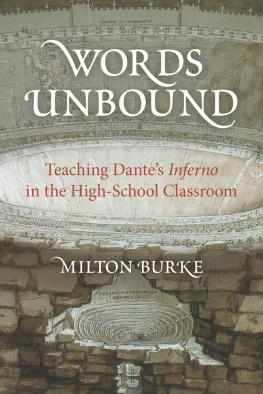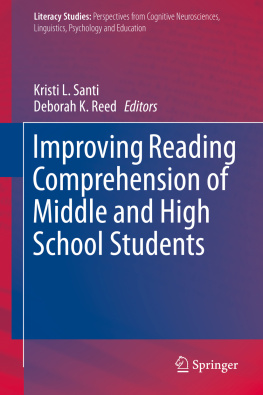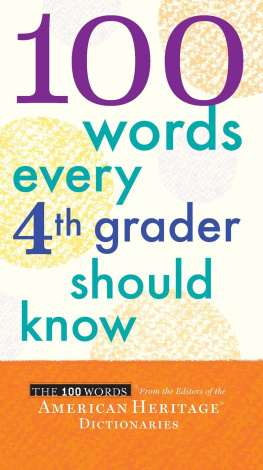THE 100 WORDS is a registered trademark of Houghton Mifflin Harcourt Publishing Company.
Copyright 2004 Houghton Mifflin Harcourt Publishing Company.
All rights reserved.
No part of this work may be reproduced or transmitted in any form or by any means, electronic or mechanical, including photocopying and recording, or by any information storage or retrieval system without the prior written permission of Houghton Mifflin Harcourt unless such copying is expressly permitted by federal copyright law. Address inquiries to Reference Permissions, Houghton Mifflin Harcourt, 222 Berkeley Street, Boston, MA 02116.
Visit our websites: hmhco.com and ahdictionary.com
ISBN -13: 978-0-544-79118-3
THE LIBRARY OF CONGRESS HAS CATALOGED THE PRINT EDITION AS FOLLOWS:
100 words every high school freshman should know / by the editors of the American heritage dictionaries.
p. cm.
ISBN 0-618-44379-7
1. VocabularyJuvenile literature. I. Title: One hundred words every high school freshman should know.
PE 1449. A 144 2004
428.1dc22
2003067539
Drawings on pages by Robin Storesund.
Drawing on (bottom) by Academy Artworks.
Drawing on by Laurel Cook Lhowe.
Cover design by Christopher Moisan Houghton Mifflin Harcourt
e ISBN 978-0-547-35026-4
v1.0916
EDITORIAL STAFF OF THE
American HeritageDictionaries
MARGERY S. BERUBE ,Vice President, Publisher of Dictionaries
JOSEPH P. PICKETT ,Vice President, Executive Editor
DAVID R. PRITCHARD ,Editorial Project Director
STEVEN R. KLEINEDLER ,Senior Editor
SUSAN SPITZ ,Editor
VALI TAMM ,Editor
KIRSTEN PATEY HURD ,Associate Editor
PATRICK TAYLOR ,Associate Editor
UCHENNA C. IKONN ,Assistant Editor
Preface
The editors of the American Heritage dictionaries are pleased to present the second book in our 100 Words series, 100 Words Every High School Freshman Should Know. The words weve chosen are ones that students entering high school should have mastered or are likely to encounter in their studies during their freshman year based on our analysis of textbooks and vocabulary books used in grades seven and eight. The items constitute a well-balanced mix of terms from A to Z, combining straightforward vocabulary items, such as eclectic, formidable, and impertinent, with words taken directly from areas of study, such as polygon and ellipse from mathematics and antibody and marsupial from biology.
Entries, based on the content of the American Heritage dictionaries, are presented in an expanded layout that is easy to read and comprehend. In addition to the definitions, we have included additional example sentences to provide greater context. Similarly, we show quotations from a mix of widely assigned works by contemporary authors like Gary Paulsen (Hatchet), Maya Angelou (I Know Why the Caged Bird Sings), and John Knowles (A Separate Peace) as well as classic novelists such as Charlotte Bront (Jane Eyre), Charles Dickens (Oliver Twist), and Lewis Carroll (Alice in Wonderland). Engaging notes provide background information for some of the scientific vocabulary and delve into the fascinating histories of many other words. To encourage study skills, we have provided exercises at the end of this book for improving vocabulary and encouraging active use of the dictionary.
The first book in the 100 Words series, 100 Words Every High School Graduate Should Know, has generated an enormous amount of interestvisitors to our website, www.ahdictionary.com, have viewed the selected words hundreds of thousands of times. We have been delighted by the enthusiastic response and are encouraged by the fact that parents, teachers, and students are taking a strong interest in using dictionaries as an integral part of literacy and vocabulary building. We hope that you will enjoy learning (or learning more about) the words in 100 Words Every High School Freshman Should Know and that you will find expanding your vocabulary to be a rewarding experience.
Steve Kleinedler,
Senior Editor
Guide to the Entries
THIS GUIDE EXPLAINS THE CONVENTIONS USED IN THIS BOOK .
ENTRY WORD The 100 words that constitute this book are listed alphabetically. The entry words, along with inflected and derived forms, are divided into syllables by centered dots. These dots show you where you would break the word at the end of a line. The pronunciation of the word follows the entry word. Please see the key on for an explanation of the pronunciation system.
PART OF SPEECH At least one part of speech follows each entry word. The part of speech tells you the grammatical category that the word belongs to. Parts of speech include noun, adjective, adverb, transitive verb, and intransitive verb. (A transitive verb is a verb that needs an object to complete its meaning. Wash is a transitive verb in the sentence I washed the car. The direct object of wash is the car. An intransitive verb is one that does not take an object, as sleep in the sentence I slept for seven hours. Many verbs are both transitive and intransitive.)
INFLECTIONS A words inflected forms differ from the main entry form by the addition of a suffix or by a change in the base form to indicate grammatical features such as number, person, or tense. Inflected forms are set in boldface type, divided into syllables, and given pronunciations as necessary. The past tense, past participle, and the third person singular present tense inflections of all verbs are shown. The plurals of nouns are shown when they are spelled in a way other than by adding s to the base form.
ORDER OF SENSES Entries having more than one sense are arranged with the central and often the most commonly sought meanings first. In an entry with more than one part of speech, the senses are numbered in separate sequences after each part of speech, as at flourish.
EXAMPLES OF USAGE Examples often follow the definitions and are set in italic type. These examples show the entry words in typical contexts. Sometimes the examples are quotations from authors of books. These quotations are shown within quotation marks, and the quotations author and source are shown.
RELATED WORDS At the end of many entries, additional boldface words appear without definitions. These words are related in basic meaning to the entry word and are usually formed from the entry word by the addition of a suffix.
NOTES Many entries include additional information about the entry words. Some notes explain a scientific concept in greater detail, as at hologram and ozone. Other notes provide information about the background or history of a word, as at quarantine and yacht.
EXERCISES At the end of this book, there is a section containing exercises designed to help you further strengthen your vocabulary.
Pronunciation Guide
Pronunciations appear in parentheses after boldface entry words. If a word has more than one pronunciation, the first pronunciation is usually more common than the other, but often they are equally common. Pronunciations are shown after inflections and related words where necessary.
Stress is the relative degree of emphasis that a words syllables are spoken with. An unmarked syllable has the weakest stress in the word. The strongest, or primary, stress is indicated with a bold mark (). A lighter mark () indicates a secondary level of stress. The stress mark follows the syllable it applies to. Words of one syllable have no stress mark because there is no other stress level that the syllable can be compared to.
Next page








